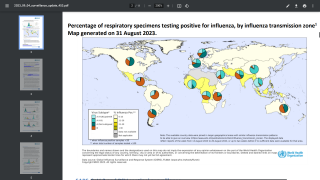Enhanced Influenza Vaccine Protects Children Best

New real-world data focused on cell-based quadrivalent seasonal influenza vaccine (QIVc) was recently published in the journal Vaccines.
This CSL Seqirus-funded study evaluated data from 16 studies over four flu seasons and is the latest to underscore the measurable value of QIVc or the relative VE (rVE) for children compared to older egg-based QIV (QIVe) vaccines.
While few studies have specifically focused on evaluating the VE of QIVc in pediatric patients, multiple studies have included pediatric patients in their overall assessments of QIVc, with many performing subgroup analyses by age group.
As children are the primary age group contributing to influenza transmission, vaccination of pediatric patients is particularly important, both for individual protection and at a public health level.
Published in October 2023, in the overall pediatric and adult population, significant benefits of using QIVc over QIVe were seen in a three-season study in the U.S., which evaluated laboratory-confirmed outpatient cases, with rVE estimates of 10.0–14.8% across seasons.
For medically attended influenza, significant benefits of using QIVc were observed regarding influenza-related medical encounters in most seasons, although the trends were not crucial in a couple of studies.
Similarly, most studies found significant benefits of using QIVc in reducing hospitalization rates in pediatric populations.
Across all studies, using QIVc was associated with significantly lower rates of pneumonia-related (point estimates of rVE: 21.5–33.0% across studies).
As well as asthma/COPD/bronchial hospitalizations (point estimates of rVE: 13.0–13.4%) compared with QIVe recipients.
In the one study that focused on the evaluation of QIVc versus QIVe in the pediatric population only, the rVE against both influenza-related medical events and outpatient-only events was higher for QIVc, with estimates of 12.2% (95% CI: 7.5% to 16.6%) and 14.3% (9.3% to 19.0%), respectively.
Of the estimates available, the rVE was variable by strain, and the VE estimates for QIVc were generally in the same range as the VE of QIVe, with overlapping 95% confidence intervals between VE estimates or overlapping zero in the case of rVE estimates.
Additionally, data from adult populations generally indicate a higher VE against laboratory-confirmed, medically attended, and hospitalization endpoints for QIVc compared with QIVe in younger adults (18–64 years) and no differences between the vaccines in adults older than 65.
Vaccination of children has been shown to protect against influenza for other vulnerable groups, such as older adults; therefore, maximizing protection in children can have beneficial effects at a population level.
Joaquin F. Mould-Quevedo, Ph.D., Global Health Economics and Value Strategy Director at CSL Seqirus, commented via email in this article, "This study demonstrates the clinical and economic benefits of a cell-based influenza vaccine for the pediatric population."
"It is another great example of the importance of pushing vaccine innovation forward to help protect public health, especially amongst some of our most vulnerable populations and at a time when influenza vaccination rates are concerningly low."
In line with this clinical finding, a cost-effectiveness analysis shows that using QIVc in pediatric populations is cost-effective and, in some cases, cost-saving at a societal level, with increased costs offset by population-level improvements in influenza-related health outcomes and reductions in healthcare service utilization.
Overall, while there are limited data on the impact of QIVc in pediatric populations, this study's results indicate incremental benefits against medically attended influenza and hospitalizations.
As of November 20, 2023, the U.S. CDC recommends that children obtain an annual flu shot, such as the Flucelvax® Quadrivalent (QIVc) vaccine, which is available at various health clinics and pharmacies.
Many children's vaccinations in the U.S. are funded by the CDC's Vaccine for Children program.
Article updated on Nov.21, 2023 to include Joaquin F. Mould-Quevedo, Ph.D. quote.
Our Trust Standards: Medical Advisory Committee
























